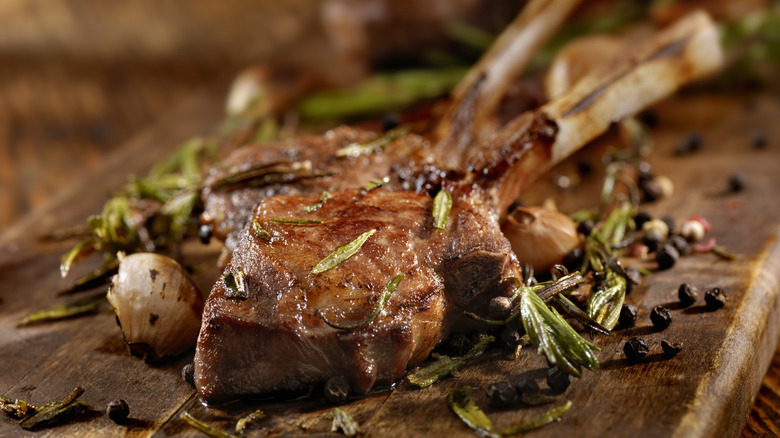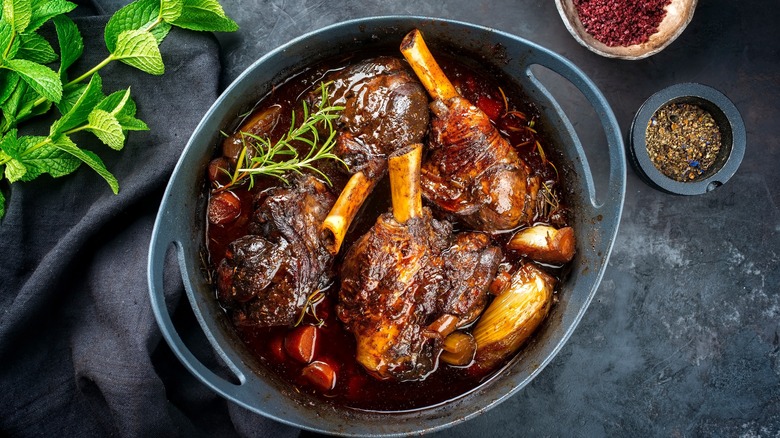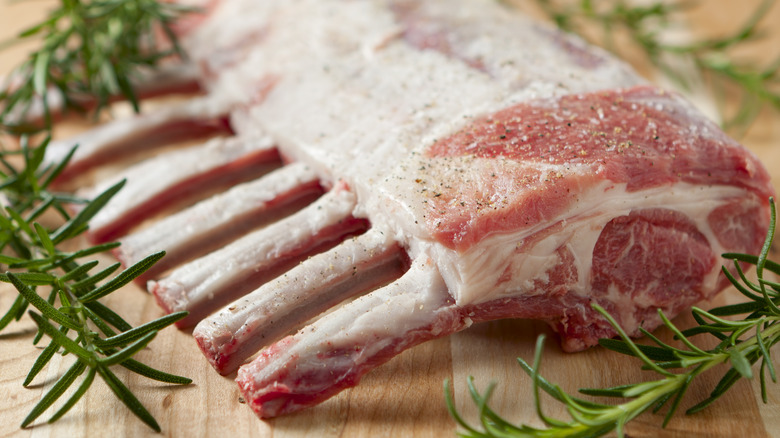A Professional Weighs In On How To Embrace The Gamey Taste Of Lamb
Whether you're tentative beginner when it comes to eating lamb or a seasoned connoisseur, you probably know one thing for sure: It's got a distinctly gamey flavor that you either love or hate. While the flavor of this meat can take some getting used to, many diners unfairly dismiss it and stick to more popular cuts, or try every trick in the book to make lamb less gamey. Rather than writing it off, it might just be worth it to embrace this animal's unique profile.
To learn more about how to enhance lamb's character, Daily Meal spoke to Rich Parente, chef and owner of Clock Tower Grill and the Clock Tower Farm, an agricultural property dedicated to ethically raising pigs and lambs for use in his restaurant. When it comes to whether or not to lean into the natural taste of lamb, Parente has this to say: "[Home cooks] should absolutely embrace the gamey flavor," and to "enjoy what makes it unique and different from your usual steak."
Ready to start learning how to love lamb? As Parente notes, "A lamb steak or chop cooked on the grill is a great way to highlight that natural lamb flavor." When you cook it on the grill, you caramelize the lamb's flavorful fat, which bastes the meat and enhances that strong taste. According to this expert, the right cooking technique can highlight the taste of the meat, creating a meal that's delicious in its own right and far more memorable than generic beef and pork.
Other preparations that bring out the flavor of lamb
Grilling is just one method to help lamb shine. Rich Parente also loves braising lamb neck, as the cut, "has a lot of connective tissue that breaks down over the long cooking time to yield a super flavorful and rich dish." Neck meat is a cut you should stop overlooking, and braising it leads to a dish that's extra juicy, delivering the taste of the lamb right to your taste buds. If you marinate the neck first, you can have fun using different herbs and spices enhance the flavor (Pro-tip: rosemary is one of the best pairings for lamb).
If you want to veer into more adventurous culinary territory, it might be worth your while to explore different cuts of lamb and various preparations you may have never thought of. Rather than sticking to the usual rack of lamb or kebabs, Parente offers a different suggestion: "Lamb bacon, made from the fatty belly, is also great and something I prepare at the restaurant [...] Guests love it!" You'll still get the crispiness of regular pork bacon, but with a noticeably gamey flavor. Some lamb bacons have sweeter notes that work well with sugary breakfast foods topped with maple syrup, making for a unique twist on your morning meal.
To be thrifty, you can also make a lamb gravy from the rendered fat left over in the pan after roasting or searing it. Top off your entree with the sauce, and you've got a double whammy (double lamb-y?) of flavor.
One type of lamb is less gamey than the other
Even if you're game (no pun intended) when it comes to embracing the flavors of lamb, it can still be intimidating to jump right into it. If you want to ease yourself into lamb's specific gamey taste, Rich Parente explains that one way to do so is to pay attention to where your lamb comes from. "Eating a good, locally raised American lamb will likely be less gamey than a New Zealand lamb bought at the grocery store," he notes.
The reason why New Zealand lamb tends to have a stronger taste has to do with the animal's diet. The country's lambs are usually fed with grass, which leads to a more noticeable tastebud-riddled pungency. In the United States, on the other hand, lambs' diets can be supplemented (or entirely made up of) grain and other types of non-grass feed, so the flavor is more subtle. Whether you dive right into eating a fatty New Zealand cut, or start slow and pick up some American meat, you might find that you enjoy lamb more than you ever thought possible, once you stop trying to tame it.


